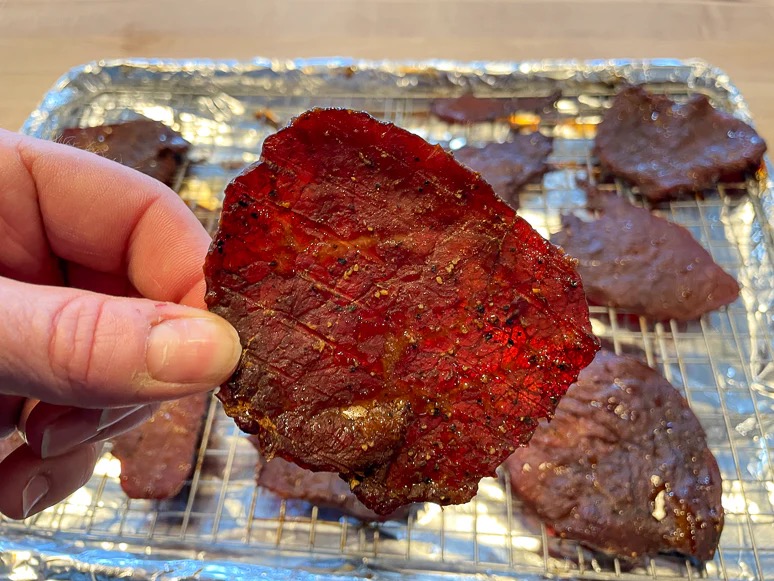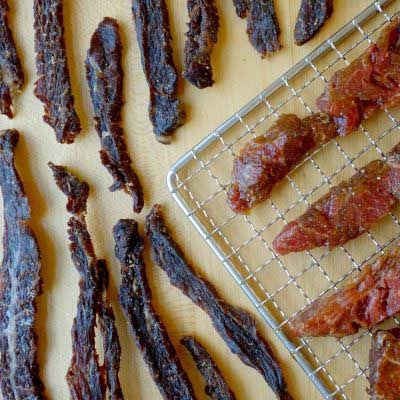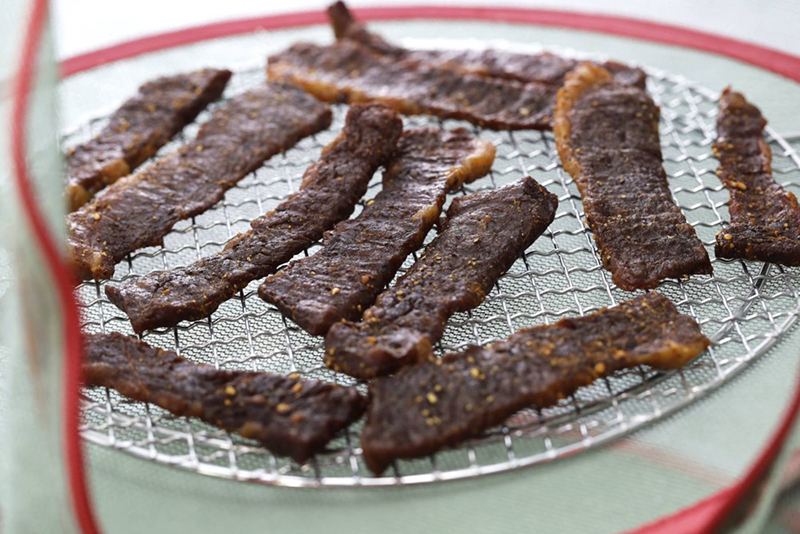
Content Menu
● Understanding Food Dehydration
>> Key Benefits of Using a Food Dehydrator
● The Dehydration Process for Meat
>> Preparation Steps for Dehydrating Meat
● Dehydrating Meat Safely
>> Recommended Dehydrating Temperatures
● Best Practices for Dehydrating Meat
● Additional Tips for Successful Meat Dehydration
● Conclusion
● FAQ
>> 1. Can I dehydrate raw meat without cooking it first?
>> 2. How long does it take to dehydrate meat?
>> 3. What types of meat are best for dehydration?
>> 4. How should I store dehydrated meat?
>> 5. Can I rehydrate dried meat?
● Citations:
Food dehydrators are versatile kitchen appliances that serve a crucial role in food preservation, particularly for fruits, vegetables, and meats. This article will explore the question, "Does a food dehydrator cook meat?" by discussing the dehydrating process, safety measures, and best practices for dehydrating meat effectively.

Understanding Food Dehydration
Food dehydration is the process of removing moisture from food to inhibit bacterial growth and spoilage. This method not only extends the shelf life of various foods but also concentrates their flavors and nutrients. A food dehydrator operates by circulating warm air at low temperatures, which helps maintain the integrity of the food's nutritional value while drying it out.
Key Benefits of Using a Food Dehydrator
- Extended Shelf Life: One of the most significant benefits of an electrical food dehydrator machine is its ability to extend the shelf life of your food. By removing moisture, the dehydrator inhibits bacterial growth and spoilage, allowing you to store your favorite fruits, vegetables, and snacks for months. This means fewer trips to the grocery store and less food waste.
- Nutrient Retention: Unlike some preservation methods that can degrade the nutritional value of food, dehydration helps retain essential vitamins and minerals. The electrical food dehydrator machine ensures that your dried fruits and veggies maintain their health benefits, giving you a nutritious snack option without added preservatives.
- Cost-Effective Preservation: Investing in a food dehydrator can save you money in the long run. Dehydrating your food at home is often more cost-effective than purchasing pre-packaged dried goods. With an electrical food dehydrator machine, you can buy in bulk and preserve your food at a fraction of the cost.
- Convenience and Versatility: An electrical food dehydrator machine offers unparalleled convenience. It allows you to dehydrate a variety of foods, from fruits and vegetables to herbs and even meats. This versatility makes it an indispensable tool for anyone interested in exploring different preservation methods and recipes.
- Healthy Snack Options: Say goodbye to unhealthy snacks laden with preservatives and additives. Dehydrated snacks are a healthier alternative. You can make your own dried fruit, vegetable chips, or jerky, ensuring that you control the ingredients and enjoy guilt-free treats.
- Space-Saving Storage: Dried food takes up significantly less space than fresh or frozen alternatives. By using an electrical food dehydrator machine, you can store more food in less space, making it easier to organize your pantry and reduce clutter.
- Enhanced Flavor Concentration: Dehydration concentrates the flavors of fruits and vegetables, making your snacks more flavorful. Whether you're enjoying a sweet apple chip or a savory vegetable crisp, the taste is intensified, providing a more satisfying snacking experience.
- Eco-Friendly Preservation: Using an electrical food dehydrator machine is an eco-friendly choice. It reduces food waste by enabling you to preserve excess produce. Moreover, it uses less energy compared to freezing, making it a greener option for food storage.
- Preparation for Cooking: Dehydrated foods can be rehydrated for cooking, adding a new dimension to your culinary repertoire. You can prepare soups, stews, and other dishes with dried ingredients, making meal preparation more efficient and flavorful.
The Dehydration Process for Meat
When it comes to dehydrating meat, the process is slightly different than for fruits or vegetables. While a food dehydrator does not technically "cook" meat in the traditional sense, it can dry it out to a point where it becomes safe to eat if done correctly.
Preparation Steps for Dehydrating Meat
1. Choose Lean Cuts: Select lean cuts of meat to minimize fat content, which can go rancid during storage.
2. Trim Excess Fat: Remove all visible fat from the meat before dehydrating.
3. Cut into Uniform Pieces: Slice the meat into uniform pieces (about 1/8 to 1/4 inch thick) to ensure even drying.
4. Marinate or Season: Optionally marinate or season the meat to enhance flavor.
5. Pre-Cook (Recommended): To ensure safety, it's advisable to pre-cook meat to an internal temperature of at least 160°F (72°C) for beef and 165°F (74°C) for poultry before placing it in the dehydrator. This step kills harmful bacteria that could survive during the dehydration process.

Dehydrating Meat Safely
While many people skip pre-cooking their meat before dehydrating, this practice can pose health risks. The USDA recommends cooking meat beforehand to eliminate pathogens like Salmonella and E. coli that could survive in a dehydrator's environment.
Recommended Dehydrating Temperatures
- Beef Jerky: Dehydrate at 145°F (63°C) for approximately 6 hours.
- Poultry Jerky: Dehydrate at 165°F (74°C) until dry.
These temperatures ensure that any harmful bacteria are destroyed while allowing the meat to dry effectively.
Best Practices for Dehydrating Meat
- Check Your Dehydrator's Capabilities: Ensure your dehydrator can reach and maintain safe temperatures for drying meat.
- Avoid Overcrowding: Space out pieces on trays to allow proper air circulation around each piece.
- Regularly Monitor Progress: Check on your meat periodically throughout the drying process to ensure even drying and prevent over-drying.
- Store Properly: Once fully dried, store jerky in vacuum-sealed bags or airtight containers in a cool, dark place to extend its shelf life further.
Additional Tips for Successful Meat Dehydration
1. Use Non-Stick Trays: To prevent sticking during dehydration, consider using non-stick trays or lining them with parchment paper specifically designed for dehydrators.
2. Rotate Trays Regularly: If your dehydrator has multiple trays stacked vertically, rotate them every few hours to ensure even drying across all trays since heat distribution may vary.
3. Monitor Moisture Levels: After dehydration is complete, check if any pieces remain sticky or moist; if so, return them to the dehydrator until fully dry.
4. Vacuum Seal for Longevity: For long-term storage of dried meats like jerky or other snacks, vacuum sealing is highly recommended as it removes air that can lead to spoilage.
5. Label Your Containers: Always label containers with dates so you can keep track of how long your dried meats have been stored; this helps ensure freshness when consumed later.
Conclusion
In summary, while a food dehydrator does not cook meat in the conventional sense, it can effectively dry it out when used properly. Pre-cooking is essential for ensuring food safety when preparing dried meats like jerky. By following recommended practices and guidelines—such as selecting lean cuts of meat, trimming excess fat, pre-cooking properly before dehydration—you can safely enjoy delicious homemade jerky and other dried meats that retain their flavor and nutritional value while extending their shelf life significantly.

FAQ
1. Can I dehydrate raw meat without cooking it first?
No, it is recommended to cook meat to safe internal temperatures before dehydrating to eliminate harmful bacteria.
2. How long does it take to dehydrate meat?
Dehydrating times vary by type of meat but typically range from 4 to 6 hours at appropriate temperatures.
3. What types of meat are best for dehydration?
Lean cuts of beef, turkey, and chicken are ideal choices due to their lower fat content.
4. How should I store dehydrated meat?
Store dehydrated meat in vacuum-sealed bags or airtight containers in a cool, dark place to maximize shelf life.
5. Can I rehydrate dried meat?
Yes, you can rehydrate dried meat by soaking it in water or broth before using it in recipes.
Citations:
[1] https://etsolutions.in/10-amazing-benefits-of-electrical-food-dehydrator-machines/
[2] https://www.youtube.com/watch?v=Zba3N9H6fTE
[3] https://www.cnet.com/pictures/tips-for-using-your-new-dehydrator/
[4] https://www.aromaco.com/recipes/best-beef-jerky/
[5] https://www.webstaurantstore.com/guide/741/food-dehydrators-buying-guide.html
[6] https://explorenborgen.com/dehydrating-meat/
[7] https://www.backpackingchef.com/dehydrating-food.html
[8] https://www.bestbuy.com/discover-learn/10-reasons-to-buy-a-food-dehydrator/pcmcat1634332391134
[9] https://www.dehydratorsamerica.com/post/hunting-and-using-dehydrators-to-store-large-amounts-of-meat
[10] https://www.osbheatpump.com/news/how-to-use-a-food-dehydrator-10-useful-tips-for-beginners-and-advanced-users/











